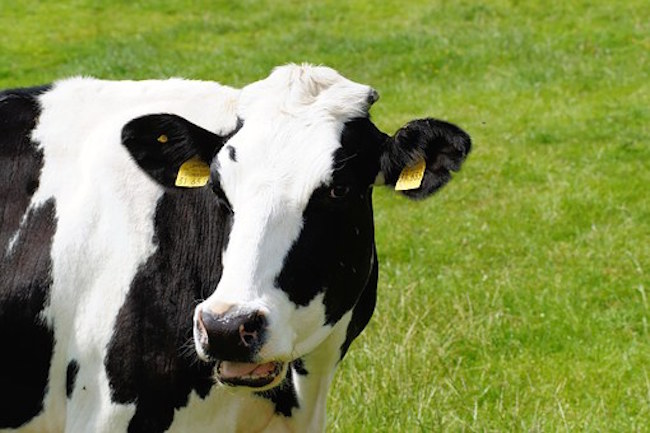Are Gene Edited Cows or Humans What We Really Need?: F. William Engdahl for Journal NEO
Scientists using the “second generation” of genetic manipulation technology have used gene-editing to alter the DNA of breed of cattle so that they supposedly do not grow horns. At around the same time another group of scientists claim to have injected human cells into monkeys to create chimeras, as in the ancient Greek myths of beings part lion, part snake. Earlier this year a group of Chinese researchers claimed to have deliberately gene-edited monkey clones with a mental disturbance. What few realize is that all this is taking place almost entirely without any serious health and safety regulation. Is this what mankind really needs at this juncture?
Gene-edited hornless cows
Scientists at the biotech company Recombinetics have filed a patent on cattle it has genetically engineered to not grow horns using gene-editing methods. They claimed the process to be safe and effective. However tests by scientists at the US Food and Drug Administration revealed that the CRISPR gene-editing process resulted in “unexpected alterations” of the genome, including “complex genomic rearrangements at or near the target site in 34 mammalian genome editing experiments.”
The FDA researchers found gene-editing errors in the genome of the animals that were being overlooked. They identified major unintended effects. The gene scissors used, known as TALENs, are often described as highly precise. However, the FDA research showed that apart from the desired gene sequences being inserted into the genome, DNA originating from genetically engineered bacteria used in the process was also inserted. Specifically, they found presence of unintended antibiotic resistance genes in the gene-edited cattle. Recombinetics reports that it is also developing a precision gene-editing breeding method to eliminate the need to castrate pigs. Unintended effects?
Human Monkey Brain?
In another recent application of the gene-editing technology, an international group of scientists working in China have used gene-editing to produce human-monkey chimeras. According to the Spanish paper, El Pais, a team of researchers led by Prof Juan Carlos Izpisúa Belmonte from the Salk Institute in the USA have produced monkey-human chimeras. The report says that the research was conducted in China “to avoid legal issues.” That should give pause.
Belmonte’s team states that the research is aimed at solving the problem of lack of organ donors as well as organ transplant rejection. Belmonte apparently has managed to produce both pig embryos and sheep embryos which contain human cells. They took cells from an adult human and reprogrammed them to become stem cells, which can give rise to any type of cell in the body. They are then introduced into the embryo of another species, such as the monkey or sheep or pigs.
Commenting on the implications of using gene-editing to produce human-animal chimeras, Prof Robin Lovell-Badge, a biologist from London’s Francis Crick Institute admits potential problems: “How do you restrict the contribution of the human cells just to the organ that you want to make?” he said. “If that is a pancreas or a heart or something, or kidney, then that is fine, if you manage to do that. [But] if you allow these animals to go all the way through and be born, if you have a big contribution to the central nervous system from the human cells, then that obviously becomes a concern.”
Other controversial China CRISPR gene-editing experiments have involved adding human brain genes, MCPH1, or microcephalin to monkeys. The gene-editing scientist, Bing Su, claimed, based on very small test results, that the monkeys seemed to be “smarter.” Bing Su and collaborators at the Yunnan Key Laboratory of Primate Biomedical Research exposed monkey embryos to a virus carrying the human version of microcephalin. They generated 11 monkeys, five of which survived to take part in a battery of brain measurements. The monkeys each have between two and nine copies of the human gene in their bodies. University of Colorado geneticist, James Sikela is critical: “The use of transgenic monkeys to study human genes linked to brain evolution is a very risky road to take.”
These are only several of the more alarming recent experiments using gene-editing CRISPR. The significant problem is that there is no scientific neutral oversight as to what experiments are being done. Because CRISPR requires very little relative investment in technology, it can be widely used even by irresponsible experimenters.
CRISPR Dangers
CRISPR is defined as a “RNA-guided gene-editing platform that makes use of a bacterially-derived protein (Cas9) and a synthetic guide RNA to introduce a double strand break at a specific location within the genome.” The widespread experimenting with CRISPR-CAs9, the currently most widely used, has only been around since about 2015. Geneticists back in the 1970’s were restricted to costly labs using highly trained scientists and strict controls. With CRISPR gene editing, the process is extraordinarily cheap and seemingly easy to use. As one critic described it, “anyone can buy some CAS9 for a few hundred bucks, any halfway decent lab can use it to alter the DNA of anything…We might be able to wipe out entire species on a whim…”
Potentially CRISPR gene-editing technology might enable positive change as well, such as treatments for genetic diseases; altering the germline of humans, animals, and other organisms; and modifying the genes of food crops for positive traits. We don’t know at this point. Yet the degree of unbiased scientific and government oversight over use of CRISPR is appalling.
Lack of Regulatory Oversight
In 2018 European Court of Justice ruled that organisms that arise from a new technique called directed mutagenesis (gene-editing) are GMOs as defined by the EU GMO Directive. As such they should be regulated in the same strict way as GMOs produced in the EU using older techniques. The ruling was greeted as a sane, rational step to insure the health and safety of people and the planet is priority.
The interests backing CRISPR and other gene-editing, were not pleased. However, immediately the ECJ ruling was attacked as a departure from “science based decision making” and “backward looking and hostile to progress,” even though the judges carefully consulted a variety of expert scientists. The powerful GMO industry lobby has organized an effort to have the new EU Commission create “a new legal regulatory framework for these new techniques,” one that is far less restrictive we can be sure.
In the US where Monsanto and the GMO industry has succeeded in creating effectively no government regulation of GMO plants such as corn or soybeans or cotton, the biotech industry has been more successful. The USDA recently proposed excluding the new gene-editing technologies such as CRISPR from in effect any regulation. This ignores the purpose of such regulation which is to hold the health and safety of the individual and of the environment paramount to any potential marketing gains from easy regulation. It is the well-established Precautionary Principle. That principle holds that government has a social responsibility to protect the public from exposure to harm, when scientific investigation has found a plausible risk. The onus of proof is on the GMO industry not the public. Just because they call their work “biotech” does not axiomatically mean that it is good for us. That we must carefully evaluate, most especially in a field such as gene-editing with the potential to “wipe out entire species on a whim …”
F. William Engdahl is strategic risk consultant and lecturer, he holds a degree in politics from Princeton University and is a best-selling author on oil and geopolitics, exclusively for the online magazine “New Eastern Outlook.”




